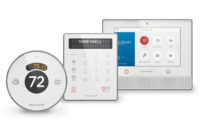Virtually no one says that anymore. Today if your firm is making a profit installing alarms and intercoms and home automation systems and central vacuums, you're likely to be asked to speak to your peers at an ISC show about your business plans.
It's too early to predict how successful these diversified, low-voltage home systems contractors will be - especially those with a security background. The home systems industry isn't even close to mass market stage. In security dealers' favor, however, is a base of satisfied customers who have placed their trust in the dealers' ability to enhance their lifestyles.
This scenario fits Paul Bedoe exactly.
Paul started his business - All Protection Alarm - nearly 20 years ago, after working for a short time in the alarm screen manufacturing business. He and his wife, Lynne Bedoe, staked a spot in Big Bear Lake, Calif., a ski resort town in the San Bernardino Mountains, which he describes as "a nice place to raise a family." The area is vastly populated with vacation homes that are often unoccupied, and provided a sure market for security and fire alarm systems.
"When we first started, the goal was to add as many simple, but quality, security and fire alarm systems in cabins and small businesses to build the recurring revenue base. We would not even consider an alarm that wasn't going to generate recurring revenue," Bedoe says.
In fact, this concept was so important to Bedoe that after only three years, he established his own central station. The first set-up was with company-owned receivers that were manned by a local communications company. Eventually, All Protection Alarm moved the equipment onsite to its own central station. The primary reason for establishing a local connection for alarm signaling was the poor quality of telephone service in and out of Big Bear Lake, Bedoe says.
Over the years, Paul and his team became the premier alarm provider in Big Bear Lake. Today, All Protection Alarm has 2,200 subscribers (75 percent residential). Bedoe estimates his market share is about 80 percent of all the security and fire alarms in Big Bear Lake.
Yet, growth has slowed in recent months, causing Bedoe to rethink the future.
"We will probably have a net gain each month of 10 new monitored accounts. That's going to be OK, but if we want to make a few extra bucks and help the company continue to prosper, we have to look at different avenues."
Equally important to Bedoe are the company's 12 employees. He is motivated to "keep their jobs secure" and avoid layoffs.
With the nearest town an hour's drive away, geographic expansion would be difficult, Bedoe says. A sound option then, is for Bedoe to tap his company's existing customer base, which he thinks will be interested in additional products and services, such as home computer networks, home controls, intercoms, and perhaps even remote video monitoring.
Examining the Need
The decision to expand, particularly into home networks, "coincided with the Internet and technology changing," Bedoe explains. "About eight to 12 months ago, we started looking at different areas to expand and utilize our base of customers to sell them more product."Plus, our local cable company during that time has been laying all kinds of fiber. All the stuff is going to be lit, and I'm hoping there will be a demand for home networking and home computers. The cable company will activate their cable, but none of the homes and businesses are set up for internal networking to handle DSL."
Bedoe anticipates a demand for these services because many vacationers fit in working time while at Big Bear Lake. "They need high-speed access. The dial-up is just too poor," he notes.
All Protection Alarm is prewiring 20 to 40 new homes a month for security, while at the same time installing Category 5 e-wire, at three network locations in a home, for no additional charge through the end of 2001.
"Technology in our community is very backwards. Even though we're pushing this forward, we're seeing some resistance [from contractors] as not being necessary."
Sales reps will then follow-up with the homeowner for the final products and services.
"We're going to be setting up homes for high-speed access, like a phone company's DSL or cable modem access. If they go with cable modem, then we'll take the cable modem at the location where it comes in the house. We'll put a router in and assign different IP addresses for the different computer stations in the house. We can do the same thing with telephone company DSL ... so two or three computers can be online at the same time without having to pay additional fees."
Bedoe plans to use his current installation team for these jobs, and to consult with his oldest son, a computer science professional, for technical guidance.
The company's plans in this area are rather loose right now, because they are dependent on the phone and cable companies' progress. "We've wired some homes, but there's nowhere for that wire to go now, because the cable's not lit. It should be within the next six months."
When the time comes, marketing plans include both billing stuffers and getting the word out to the local contractors' association.
That part of All Protection Alarm's future depends on the progress of the telephone/cable companies. Where Bedoe has greater control, however, is in other areas of expansion, such as home automation and HVAC controls.
To start, his firm has selected an alarm panel, the Networx NX8 from Caddx Controls Inc., an Interlogix company, which allows him to add home automation capabilities, including heating control, with the use of X10 Pro products.
"The sales of these products really represent a miniscule percentage right now. We've installed heating controls, but not to the extent or the technology that we would like to.
"The heating systems being installed now are much more complex than just a standard thermostat, so we have to get involved with a little higher technology systems that will work with the newer HVAC systems. For that we are going to try to new X10 system, model PDT20, in conjunction with the Caddx NX8."
As a preliminary means of gauging interest in home automation, All Protection Alarm recently conducted a survey of about 100 subscribers. "The response was very slow and almost non-reactive," Bedoe states, adding that there was more interest in updating older security systems. "We actually picked up quite a few upgrades from that."
However, the lack of interest in other products didn't discourage Bedoe.
"We have to find an area that we're comfortable selling in and the customer is comfortable in purchasing. We were not dissuaded by any means, shape or form. We're going to focus on convenience and cost-savings as far as energy and improved security."
All Protection Alarm plans to use three marketing methods, beginning this summer, to reach prospective customers: telephone calls to subscribers, billing stuffers, and a home show.
"We have a great resource in the central station. Because it is automated and the installations are of such a high quality, we have very few false alarms and service-related problems. Our operators have quite a bit of free time, yet they still have to be there. So first we'll utilize the central station to do the billing stuffers and the phone calls. We'll probably start at one end of the account base and work our way through."
At the home improvement show this fall, Bedoe plans to extensively promote the automation devices. In past shows, 100 percent of the displays focused on security and fire alarm systems, as well as Uplink, the long-range radio alarm signaling system that All Protection Alarm uses. However, this year, those products will encompass about 25 percent of the exhibit, while 75 percent will be other systems, such as structured wiring, lighting controls, HVAC controls, and music intercoms.
"October is a good time in the community for people because we have a popular October Fest. It also coincides with factory training from X10 in California," Bedoe notes. He and one installer plan to attend the training.
"It's really key to the development of what we're trying to do. We have to be sold and comfortable ourselves before we dump 100 percent on the market. We don't want to get into a product where 20 or 30 units later we have nothing but a disaster on our hands."
Bedoe also plans to use local print media, and presentations at service clubs, such as Rotary.
Beyond the home automation controls and computer networking, Bedoe also plans to sell more CO, temperature, and water detectors, which the company has installed on a limited basis. Bedoe is exploring a product called WaterCop from DynaQuip Controls Corp., which senses water leaks and through a radio signal, turns off the main water supply. The company will also soon install its first stand-alone environmental system from Smart Systems Int'l, an occupancy-based heating control .
All Protection Alarm also is a customer of Music & Sound Inc. Its plans are to market more music intercom systems in the future. And further down the pike is remote video monitoring for the home, which has promise of generating additional recurring revenue.
"What made me happy before was getting a straight burg alarm in," Bedoe says.
Even though All Protection Alarm has set modest sales goals, Bedoe is appropriately cautious about the additional internal resources that will be needed. He plans to take advantage of as much manufacturer training as possible to bring installers up to speed. His first tier approach, as sales and installations increase, will be to offer technicians overtime pay; second tier will be to bring in subcontractors as needed.
He also acknowledges that end-user support will be substantial. "Even though we would like to think it's not going to have an impact, I anticipate a considerable increase in end-user training, probably in the 500 percent range. Our ace in the hole as far as user training will be the [central station] operator base, again. We'll train our operators much in the same way we train them in alarm systems?so at least the first line of questions can go through the operators?and try to get them to solve it before it gets to the service level."
Bedoe expects profits from these new systems to come in at about 5 percent, and then improve as training brings employees up to speed. And there's always recurring revenue to count on, although those revenue sources are not as clear to Bedoe as they are from monitoring alarm systems. One obvious source is maintenance contracts and extended service warantees.
"It would sure be nice to figure out some kind of recurring revenue for everything that's going on, like remote video monitoring. Not seeing that right now, we're going to focus on the automation and the things that will bring us the most profit right now."
SIDEBAR: Setting Goals & Reaching Them
Setting Goals & Reaching ThemLess than 1 percent of All Protection Alarm's revenue stems from systems other than burglar and fire alarms. However, company owner and president, Paul Bedoe, estimates that within the next 12 months, at least 10 percent of all new sales will include some automation products or systems.
"It could actually be as high as 20 to 25 percent, but we don't want to set a goal that is too far out of reach."
Bedoe estimates that home automation sales will total $50,000 to $100,000 between July 2001 and July 2002.



